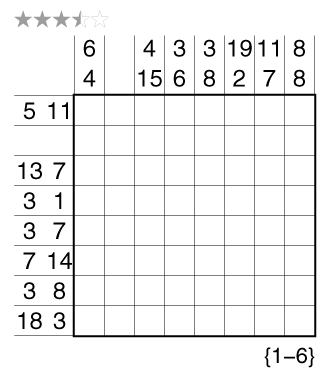Japanese Sums by Ashish Kumar

or solve online (using our beta test of Penpa-Edit tools; use tab to shift between number entry and shading modes.)
Theme: Doubles
Author/Opus: This is the 96th puzzle from our contributing puzzlemaster Ashish Kumar.
Rules: Place the numbers in the indicated range (1-6) in some of the cells so that no number is repeated in any row or column. Numbers on the outside of the grid indicate the sums of adjacent number groups in that row or column, in order. Each sum is separated by at least one unused cell.

Difficulty: 3.5 stars
Time Standards (highlight to view): Grandmaster = 4:30, Master = 8:15, Expert = 16:30
Solution: PDF and solving video.
Note: Follow this link for other Japanese Sums puzzles.









